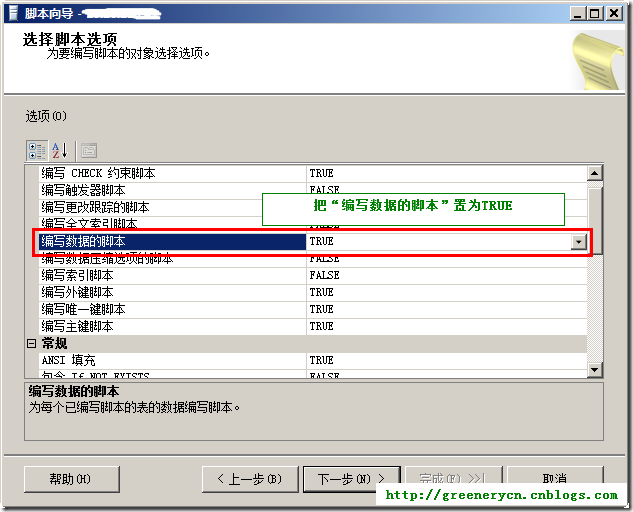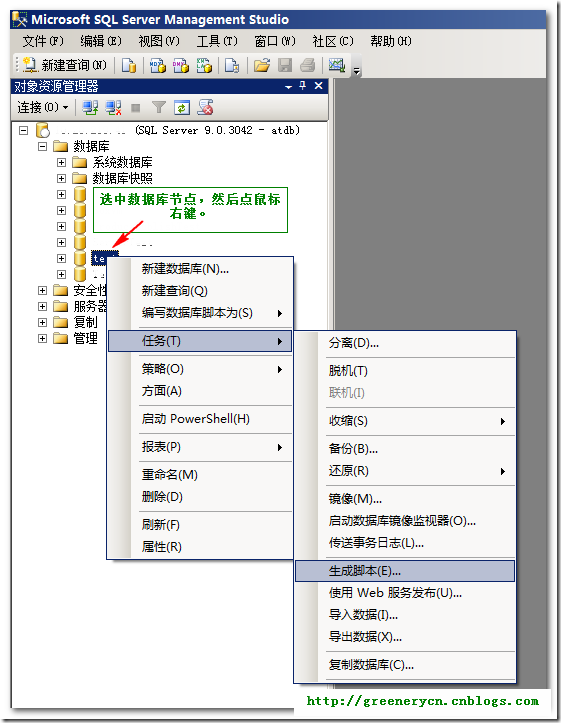最近需要将一个Sql Server 2005数据库中的数据导出,为了方便,就希望能导出成Sql文件,里面包含的数据是由Insert 语句组成的。
在Sql Server Management Studio 2005 中(包括之前Sql Server2000 的企业管理器),只能把表结构导出到Sql脚本文件中,没办法把数据导出到Sql脚本文件中。
Sql Server Management Studio 2008中增加了这个功能,因此我们可以利用2008的Management Studio工具连接2005的数据库,从而导出想要的脚本。
1.使用Sql Server Management Studio 2008 连接数据库。
2.选中要导出数据的数据库节点,点鼠标右键,在菜单中选择“任务”->“生成脚本”,如图:
3。在弹出的界面中,点2次“下一步”进入如图界面中,把“编写数据的脚步”置为true。

4。其它的操作点“下一步”即可。下图是最后生成的Sql脚本:
注意:这里一定要使用Sql Server Management Studio 2008,其它版本不行。
有问题欢迎大家留言。
[转自]http://www.cnblogs.com/greenerycn/archive/2010/04/09/SqlServer2008GenerateDataScript.html
附上一份非Sql server 导出数据的Sp
1:
2: create PROCEDURE [dbo].[UspOutputData]
3: @tablename sysname
4: AS
5: declare @column varchar(2000)
6: declare @columndata varchar(2000)
7: declare @sql varchar(8000)
8: declare @xtype tinyint
9: declare @name sysname
10: declare @objectId int
11: declare @objectname sysname
12: declare @ident int
13: set nocount on
14: -- 判?斷?對?象?是?否?存?在?
15: set @objectId=object_id(@tablename)
16: if @objectId is null
17: begin
18: print 'The object not exists'
19: return
20: end
22: set @objectname=rtrim(object_name(@objectId))
23: if @objectname is null or charindex(@objectname,@tablename)=0
24: begin
25: print 'object not in current database'
26: return
27: end
28: -- 判?斷?對?象?是?否?是?table
29: if OBJECTPROPERTY(@objectId,'IsTable') < > 1
30: begin
31: print 'The object is not table'
32: return
33: end
35: select @ident=status&0x80 from syscolumns where id=@objectid and status&0x80=0x80
36: if @ident is not null
37: print 'SET IDENTITY_INSERT '+@TableName+' ON'
38:
39: declare syscolumns_cursor cursor
40: for select c.name,c.xtype from syscolumns c where c.id=@objectid order by c.colid
41: open syscolumns_cursor
42: set @column=''
43: set @columndata=''
44: fetch next from syscolumns_cursor into @name,@xtype
45: while @@fetch_status < >-1
46: begin
47: if @@fetch_status < >-2
48: begin
50: begin
51: set @column=@column+case when len(@column)=0 then'' else ','end+@name
52: set @columndata=@columndata+case when len(@columndata)=0 then '' else ','','','end
53: +case when @xtype in(167,175) then '''''''''+'+@name+'+''''''''' --varchar,char
54: when @xtype in(231,239) then '''N''''''+'+@name+'+''''''''' --nvarchar,nchar
55: when @xtype=61 then '''''''''+convert(char(23),'+@name+',121)+''''''''' --datetime
56: when @xtype=58 then '''''''''+convert(char(16),'+@name+',120)+''''''''' --smalldatetime
57: when @xtype=36 then '''''''''+convert(char(36),'+@name+')+''''''''' --uniqueidentifier
58: else @name end
59: end
60: end
61: fetch next from syscolumns_cursor into @name,@xtype
62: end
63: close syscolumns_cursor
64: deallocate syscolumns_cursor
65: set @sql='set nocount on select ''insert '+@tablename+'('+@column+') values(''as ''--'','+@columndata+','')'' from '+@tablename
66: print '--'+@sql
67: exec(@sql)
69: if @ident is not null
70: print 'SET IDENTITY_INSERT '+@TableName+' OFF'
71:
72: GO
73:
74:
75:

